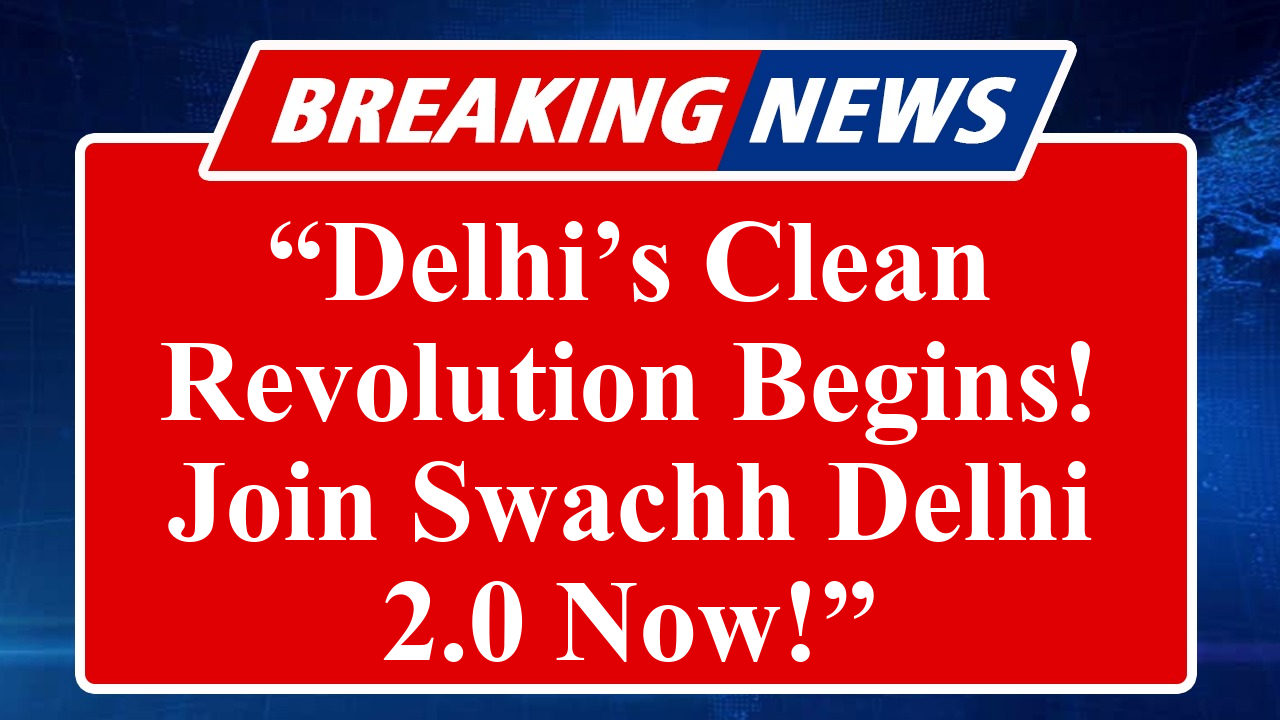“Swachh Delhi 2.0, launched in 2025, aims to transform the capital into a cleaner, greener city with enhanced waste management and sanitation infrastructure. Building on Swachh Bharat’s success, it focuses on sustainable practices, public participation, and advanced technology to achieve a garbage-free Delhi by 2026.”
Swachh Delhi 2.0: A Bold Step Toward a Cleaner Capital
In a bid to elevate Delhi’s sanitation standards, the Delhi government has rolled out Swachh Delhi 2.0, a revamped sanitation mission launched in early 2025. This initiative builds on the foundation laid by the Swachh Bharat Mission, aiming to make Delhi a model of cleanliness and sustainability by 2026. The mission integrates advanced waste management systems, community-driven cleanliness drives, and infrastructure upgrades to address the capital’s growing sanitation challenges.
The Delhi government has allocated ₹9,000 crore for this ambitious project, which includes a 45-point action plan to overhaul the city’s sanitation and water infrastructure. A key focus is on upgrading sewer systems and ensuring transparency in waste management operations. The plan also involves a comprehensive drone survey of 22 major drains to identify and address blockages, alongside re-verification of 360 smaller drains to prevent untreated waste from polluting water bodies like the Yamuna River.
Swachh Delhi 2.0 emphasizes sustainable waste management, with a target of 100% source segregation of waste and the establishment of functional Material Recovery Facilities (MRFs) across the city. The mission aims to phase out single-use plastics, aligning with the global theme of “Ending Plastic Pollution” highlighted during World Environment Day 2025. The initiative also promotes the 3R principle—Reduce, Reuse, Recycle—through campaigns like the Swachh Toycathon, which encourages innovative designs for toys and public spaces made from recycled waste.
Public participation remains a cornerstone of the mission. The Swachhata Hi Seva 2024 campaign, themed “Swabhav Swachhata, Sanskaar Swachhata,” saw over 17 crore people participate nationwide, with Delhi contributing significantly through cleanliness drives and Shramdaan activities. The campaign transformed 6.5 lakh Cleanliness Target Units, including public spaces, markets, and residential areas, fostering a sense of collective responsibility among Delhiites.
The mission also prioritizes the welfare of sanitation workers, with Safai Mitra Suraksha Shivirs providing health checkups and social security coverage. Over 5.5 lakh sanitation workers have been linked to welfare schemes, ensuring their safety and dignity. The Delhi government has introduced mechanized road sweepers and water sprinklers to tackle 543 identified road dust hotspots, aiming to reduce air pollution caused by dust.
Technology plays a pivotal role in Swachh Delhi 2.0. The revamped Swachhata App 2.0, launched by the Ministry of Housing and Urban Affairs, has resolved over 2 crore citizen complaints, offering a digital platform for grievance redressal. Geographic Information System (GIS)-based monitoring ensures transparency in waste management projects, from collection to disposal. Additionally, the mission collaborates with startups and private sectors to innovate solutions like IT-based waste tracking and mobile waste processing units.
Despite its ambitious goals, Swachh Delhi 2.0 faces challenges. Low waste segregation rates and inadequate adoption of advanced waste processing technologies remain hurdles, as noted in recent analyses. Interstate variations in sanitation coverage also pose a challenge, with some areas lagging in infrastructure development. Reports have highlighted irregularities in fund utilization in other states, raising concerns about ensuring accountability in Delhi’s implementation.
The mission draws inspiration from the success of Swachh Bharat Mission-Grameen, which achieved Open Defecation Free (ODF) status for over 6 lakh villages by 2019. Delhi aims to sustain its ODF status while advancing to ODF+ and ODF++ certifications, ensuring functional public toilets and safe sewage management. The establishment of the Dr. Syama Prasad Mookerjee National Institute of Water and Sanitation (SPM-NIWAS) in Kolkata supports capacity-building efforts, training urban local body representatives to implement sustainable sanitation practices.
As part of Swachh Delhi 2.0, the government is also focusing on iconic locations in the capital, with initiatives like the Swachhata Green Leaf Rating promoting sustainable tourism practices. The mission’s alignment with global Sustainable Development Goals, particularly SDG 6.2, underscores its commitment to public health and environmental sustainability. UNICEF has lauded the Swachh Bharat Mission as a global model, noting its impact on reducing diarrheal deaths and improving child health through better sanitation.
With projects worth over ₹6,800 crore under AMRUT 2.0 and the National Mission for Clean Ganga, Swachh Delhi 2.0 is set to enhance urban water and sewage systems. The mission’s holistic approach, combining infrastructure, technology, and community engagement, aims to make Delhi a garbage-free, pollution-free capital, setting a benchmark for urban sanitation across India.
Disclaimer: This article is based on recent reports, government announcements, and public data available on the web, including updates from the Swachh Bharat Mission and Delhi government initiatives. Information is sourced from credible platforms like pib.gov.in, swachhbharatmission.gov.in, and news reports. Readers are advised to verify details through official government portals for the latest updates.

